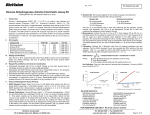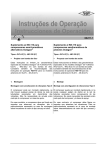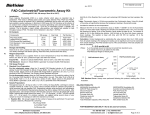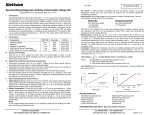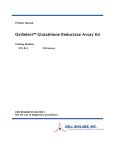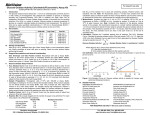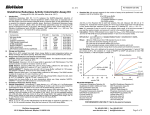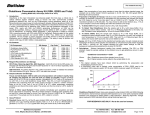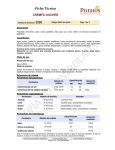Download Manual - RayBiotech, Inc.
Transcript
RayBio Glucose Dehydrogenase Activity Assay Kit User Manual Version 1.0 January 23, 2015 RayBio Glucose Dehydrogenase Activity Assay Kit Protocol (Cat#: 68AT-GluD-S100) RayBiotech, Inc. We Provide You With Excellent Support And Service Tel:(Toll Free)1-888-494-8555 or 770-729-2992; Fax:770-206-2393; Web: www.raybiotech.com Email: [email protected] RayBiotech, Inc. RayBio Glucose Dehydrogenase Activity Assay Kit TABLE OF CONTENTS I. II. III. IV. Introduction………………………………………………………………………………………. Reagents………………………………………………………………………………………………. Storage & Handling……………………………………………….…………………….. Reagent Reconstitution and General Consideration ………………………………………………………………………………….. V. Glucose Dehydrogenase Assay Protocol………..……………. VI. General Troubleshooting Guide…………………………………………. 1 2 2 2 3 5 I. INTRODUCTION Glucose 1-dehydrogenase (NAD+) (EC 1.1.1.118) is an enzyme that catalyzes the chemical reaction: D-glucose + NAD+ ↔ D-glucono-1,5-lactone + NADH + H+. This enzyme belongs to the family of oxidoreductases, specifically those acting on the CHOH group of donor with NAD+ or NADP+ as acceptor. RayBiotech’s Glucose Dehydrogenase (GDH) Assay Kit provides a convenient tool for sensitive detection of the GDH in a variety of samples. The GDH present in sample will recognize D-glucose as a specific substrate leading to a proportional color development. The activity of GDH can be easily quantified colorimetrically (λ = 450 nm). This assay detects GDH activity as low as 0.01 mU with our unit definition. RayBio Glucose Dehydrogenase Activity Assay Kit Protocol 1 II. REAGENTS Components GluD-S100 Cap Code Part Number GDH Assay Buffer 25 ml WM Item A Glucose (2 M) 1 ml Blue Item B Developer (lyophilized) 1 vial Red Item C GDH Positive Control (lyophilized) 1 vial Green Item D NADH Standard (0.5 µmol, Lyophilized) 1 vial Yellow Item E III. STORAGE AND HANDLING Store the kit at -20oC, protect from light. Allow Assay Buffer to warm to room temperature before use. Briefly centrifuge vials prior to opening. Read the entire protocol before performing the assay. IV. REAGENT RECONSSTITUTION AND GENERAL CONSIDERATION Reconstitute Developer with 0.9 ml of ddH2O. Pipette up and down several times to completely dissolve the pellet into solution (Do not vortex). Reconstitute the GDH Positive Control with 220 µl Assay Buffer; Keep on ice during the preparation and protect from light. Aliquot and store -20°C. Reconstitute the NADH with 50 µl ddH2O to generate a 10 mM NADH stock solution. The GDH Positive Control and the Developer are stable for up to 2 months at 20oC after reconstitution or freeze-thaw cycles (< 5 times). Reconstituted NADH (10 mM) and the supplied Glucose (2 M) solution are stable for up to 6 months at -20°C. RayBio Glucose Dehydrogenase Activity Assay Kit Protocol 2 V. GLUCOSE DEHYDROGENASE ASSAY PROTOCOL 1. 2. 3. NADH Standard Curve: Dilute 10 µl of the 10 mM NADH stock solution with 90 µl of Assay Buffer to generate a 1 mM NADH standard. Add 0, 2, 4, 6, 8, 10 µl of the 1 mM NADH standard into a 96-well plate in duplicate to generate 0, 2, 4, 6, 8, 10 nmol/well standards. Adjust the final volume to 50 µl with Assay buffer. Sample Preparations: Tissues (50 mg) or cells (1 x 106) can be homogenized in ~ 200µl ice-cold Assay Buffer then centrifuged (13,000 x g, 10 min.) to remove insoluble material. 5 - 50µl serum samples can be directly diluted in the Assay Buffer. Adjust the final volume of test samples to 50 µl/well with Assay Buffer in a 96-well plate. We suggest testing several doses of your sample to make sure the readings are within the linear range of the standard curve and set up the background control group to avoid interference of the NADH in the sample. For the positive control (optional), add 2 µl positive control solution to wells and adjust to a final volume of 50 µl with Assay Buffer. Reaction Mix: Mix enough reagents for the number of assays to be performed. For each well, prepare a Reaction Mix (100 µl) containing: Reaction Mix Background Control Mix 82 µl Assay Buffer 92 µl Assay Buffer 8 µl GDH Developer 8 µl GDH Developer 10 µl 2 M Glucose 4. Measurement: Incubate the mix for 3 min at 37°C, then measure OD at 450 nm in a microplate reader (A0), incubate for another 30 mins to 2 hrs at 37°C and measure OD at 450 nm again (A1), (Note: Incubation times depends on the GDH activity in your samples). We recommend measuring the OD in a kinetic method (preferably every 3 - 5 min) and choose the period of linear range to calculate the GDH activity of the samples. The NADH Standard Curve can read in Endpoint Mode (i.e., at the end of the incubation time). 5. Calculation: Subtract the 0 Standard value from all readings (standards and test samples). Plot the NADH standard Curve, then calculate the GDH activity of the test samples: ∆OD = A1 - A0, apply the ∆OD to the NADH standard curve to get B nmol of NADH generated by GDH during the reaction time (T = T2 - T1). GDH Activity = Sample Dilution Factor = nmol/min/ml = mU/ml RayBio Glucose Dehydrogenase Activity Assay Kit Protocol 3 Where: B is the glutamate amount from standard curve (in nmol). T is the time incubated. V is the sample volume added into the reaction well (in ml). Unit Definition: One unit is the amount of enzyme that will generate 1.0 µmol of NADH per min at pH 8 at 37°C. RayBio Glucose Dehydrogenase Activity Assay Kit Protocol 4 IV. General Troubleshooting Guide: Problems Cause Solution Assay not working • Use of ice-cold assay buffer • Assay buffer must be at room temperature • Omission of a step in the protocol • Refer and follow the data sheet precisely • Check the wavelength in the data sheet and the filter settings of the instrument • Fluorescence: Black plates (clear bottoms) ; Luminescence: White plates ; Colorimeters: Clear plates • Plate read at incorrect wavelength • Use of a different 96-well plate Samples with erratic readings • Use of an incompatible sample type • Refer data sheet for details about incompatible samples • Samples prepared in a different buffer • Samples were not deproteinized (if indicated in datasheet) • Cell/ tissue samples were not completely homogenized • Samples used after multiple free-thaw cycles • Presence of interfering substance in the sample • Use of old or inappropriately stored samples Lower/ Higher readings in Samples and Standards Readings do not follow a linear pattern for Standard curve • Aliquot and freeze samples if needed to use multiple times • Troubleshoot if needed • Use fresh samples or store at correct temperatures until use • Improperly thawed components • Thaw all components completely and mix gently before use • Use of expired kit or improperly stored reagents • Allowing the reagents to sit for extended times on ice • Always check the expiry date and store the components appropriately • Always thaw and prepare fresh reaction mix before use • Incorrect incubation times or temperatures • Refer datasheet & verify correct incubation times and temperatures • Incorrect volumes used • Use calibrated pipettes and aliquot correctly • Use of partially thawed components • Thaw and resuspend all components before preparing the reaction mix • Pipetting errors in the standard • Avoid pipetting small volumes • Pipetting errors in the reaction mix • Prepare a master reaction mix whenever possible • Air bubbles formed in well • Pipette gently against the wall of the tubes • Standard stock concentration Unanticipated results • Use the assay buffer provided in the kit or refer data sheet for instructions • Use the 10 kDa spin cut-off filter or PCA precipitation as indicated • Use Dounce homogenizer (increase the number of strokes); observe for lysis under microscope is at an incorrect • Always refer the dilutions in the data sheet • Calculation errors • Recheck calculations after referring the data sheet • Substituting reagents from older kits/ lots • Use fresh components from the same kit • Measured at incorrect wavelength • Check the equipment and the filter setting • Samples contain interfering substances • Troubleshoot if it interferes with the kit • Use of incompatible sample type • Refer data sheet to check if sample is compatible with the kit or optimization is needed • Sample readings above/below the linear range • Concentrate/ Dilute sample so as to be in the linear range Note: The most probable list of causes is under each problem section. Causes/ Solutions may overlap with other problems. RayBio Glucose Dehydrogenase Activity Assay Kit Protocol 5 This product is for research use only. ©2004 RayBiotech, Inc. RayBio Glucose Dehydrogenase Activity Assay Kit Protocol 6







